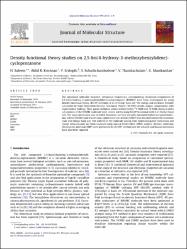Density functional theory studies on 2,5-bis(4-hydroxy-3-methoxybenzylidene)cyclopentanone

View/
Access
info:eu-repo/semantics/closedAccessDate
2011Author
Saleem, H.Krishnan, Akhil R.
Erdogdu, Y.
Subashchandrabose, S.
Thanikachalam, V.
Manikandan, G.
Metadata
Show full item recordAbstract
The optimized molecular structure, vibrational frequencies, corresponding vibrational assignments of 2,5-bis(4-hydroxy-3-methoxybenzylidene)cyclopentanone (BHMBC) have been investigated by using density functional theory (B3LYP) methods at 6-311 G(d,p) basis set. The energy and oscillator strength calculated by Time Dependent Density Functional Theory (TD-DFT) results almost compliments with experimental findings. Then, gauge-including atomic orbital (GIAO) (13)C NMR and (1)H NMR chemical shifts calculations of the BHMBC molecule were carried out by using B3LYP functional with 6-311G(d,p) basis sets. The mass spectrum is also recorded. Moreover, we have not only simulated highest occupied molecular orbital (HOMO) and lowest unoccupied molecular orbital (LUMO) but also determined the transition state and energy band gap. The stability of the molecule arising from hyperconjugative interaction and charge delocalization has been analyzed using natural bond orbital (NBO) analysis. Besides, molecular electrostatic potential (MEP) were performed by the DFT method and the infrared and Raman intensities have also been reported. (C) 2011 Elsevier B.V. All rights reserved.
Source
JOURNAL OF MOLECULAR STRUCTUREVolume
999Issue
1.MarCollections
- Scopus İndeksli Yayınlar Koleksiyonu [2612]
- WoS İndeksli Yayınlar Koleksiyonu [3255]
- Yayın Koleksiyonu [223]

















